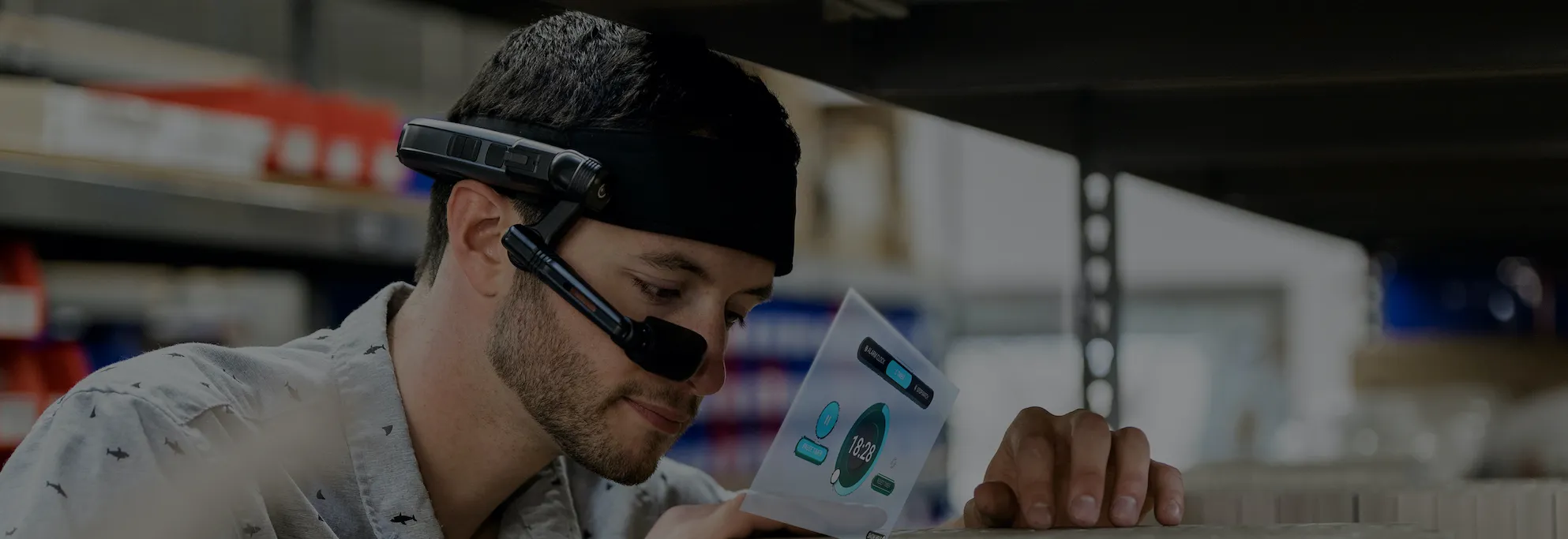Augmented reality is the solution for combining real-world experiences with digital add-ons. AR erases boundaries between what’s palpable and computer-generated, carrying previously unknown potential.
Industries benefiting from augmented reality extend from manufacturing, automotive, energy to medical fields, chemical, construction, and many others. Anywhere companies face challenges with knowledge management, efficient training, and access to sought-after experts, AR can be implemented successfully.
Augmented reality & virtual reality
AR differs from VR, as it provides an additional layer of information to our view of the real world, instead of replacing it. Augmented reality is a modern way of presenting information in a certain context – either in the context of the space that surrounds us or in the context of the activity that we perform. To learn more about differences, check out our article on AR & VR.
Depending on needs, the digitally created added layer can serve various roles, from personal spaces and entertainment to heavy-duty industrial applications, transforming the way companies function in times of Industry 4.0. AR potential in professional areas is constantly growing, and industrial companies can make great use of technology.
Smartphones & tablets
Using AR applications with popular handheld devices is one of the possibilities to try out whether augmented reality is what your enterprise needs (the other way you’ll find at the bottom of this post). This lowers the entry threshold for users who aim to introduce AR in their workplace, without making bigger investments. Devices with iOS 11.0 or Android 7.0 and later will mostly have AR software integrated, and should give a foretaste of augmented reality applications.
Using AR on handheld devices doesn’t provide an immersive experience nor show the full potential of technology. While some functionalities can be accessed via smartphones or tablets, only wearable devices allow users to work hands-free, focusing fully on the digital content and performing tasks. Additionally, the most common handheld devices are more vulnerable to damage, caused by e.g. dropping on the ground, or not being suited to withstand high temperatures, dust, or high humidity. Depending on the conditions, many industrial-grade applications need heavy-duty equipment, with only some devices meeting requirements (which applies to both handheld and wearables).
While it’s possible to use AR – to a limited extent – on everyday devices, smartphones, and tablets, its full potential unfolds while paired with dedicated equipment. The decision on which model to use depends to a large extent on the conditions in the work environment and planned scope of work. (Un)fortunately, there’s no one-size-fits-all solution, perfect in every aspect. Some glasses are more suitable for many-hours use than others, while particular models stand out with their robustness and adaptation to harsh environments.
Augmented reality glasses
The go-to solution for augmented reality applications. The most important advantages include their convenience, as users can operate most devices using voice commands and gestures while performing their duties. Features differ between models, predestining devices for particular usages.
Crucial qualities of industrial-grade AR wearable devices include
- Full mobility
- Hands-free operation
- Resilience to various conditions
- Lower risk of damage in comparison to handheld devices
- No interference with safety equipment
Most popular, proven, and appraised wearable AR devices
Working in harsh environments
RealWear HMT 1/1Z1
Specs:
| HMT-1 | HMT-1Z1 | |
| Display | 0.33”, WVGA 854×480 px | 0.33”, WVGA 854×480 px |
| Field of view | 20 degrees | 20 degrees |
| Weight | 380 g | 430 g |
| Operating system | Android 10 | Android 8.1 |
| Voice control | 13 languages | 12 languages |
| Audio | 91 dB speakers, 4 microphones | 91 dB speakers, 4 microphones |
| Memory | 32 GB internal memory/3 GB RAM/ MicroSD | 16 GB internal storage/2 GB RAM/MicroSD |
| Camera | 16 MP, 4-axis image stabilization, LED light | 16 MP, 4-axis image stabilization, LED light |
| Battery | 6-8h, 3250 mAh, hot swap | 6-8h, 3400 mAh |
| Physical buttons | On/Off, app-specific action key | On/Off, app-specific action key |
| Mounting | PPE Compatible, suitable for safety helmets, caps, and goggles | PPE Compatible, suitable for safety helmets, caps, and goggles |
| Noise cancellation | Active noise cancellation | Active noise cancellation |
| Resistance | IP66, MIL-STD-810G, dust-tight, -20° C to +50°C temperature range, resistant to streams of water and 2 meter drops onto concrete | IP66, MIL-STD-810G, dust-tight, -20° C to +50°C temperature range, resistant to streams of water and 2 meter drops onto concrete |
| Other features | WLAN & Bluetooth, 2.0 GHz 8-core Qualcomm® Snapdragon™ 626, boom arm, GPS | WLAN & Bluetooth, 2.0 GHz 8-core Qualcomm® Snapdragon™ 626, boom arm, GPS |
| Accessories | Head straps, helmet clips, chargers, LTE/4G modem, bags and casing | Overhead strap, rear pad, charging cable, helmet clips, earbud hearing protection |
| Price | $1,800.00 | $5,250.00 |
With good, also outdoors, display readability and voice control up to 95 dBa of typical industrial noises, the HMT-1 is a go-to device for demanding environments. The very rugged, heavy-duty piece is suitable for industrial uses, enabling remote support, real-time communication for approximately 8-10 in one go. Adjustable to all head sizes, left and right eye compatible.
The broad scope of voice control combined with excellent noise reduction enables efficient hands-free operation of the device. The software development kit (SDK) provided by RealWear supports the creation of bespoke commands, expanding the scope of possible actions. The HMT-1Z1 model additionally presents no ignition risks in hazardous areas per Class 1 Division 1 and ATEX & IECEx Zone 1 certifications. The device can be used in areas containing explosive gases in the atmosphere in regular operation. The Intrinsically Safe improvement was introduced at the expense of smaller memory capacity, an older version of the Android system, and a lack of hot-swappable battery, with a significantly higher price. On the downside of both versions, a slight shift in the display’s position can disturb readability and these models may often require repositioning to recover proper adjustment.
RealWear Navigator 500
Specs:
| Display | 0.32”, WVGA 854×480 px |
| Field of view | 20 degrees |
| Weight | 270 g |
| Operating system | Android 11 |
| Voice control | 15 languages (19 with dialects) |
| Audio | 100 dBA speakers, 4 microphones |
| Memory | 4GB RAM, 64 GB |
| Camera | 48 MP, superpixel, 6 zoom levels |
| Battery | 2600mAh, hot swap |
| Physical buttons | 3 programmable buttons |
| Mounting | Compatible with helmets, safety glasses, can be worn independently |
| Noise cancellation | Up to 100 dBA |
| Resistance | IP66 grade, dust and water-resistant, MIL-STD-810H |
| Other features | 662 Snapdragon, Autofocus, face detection, companion app, calculator, pedometer |
| Accessories | Multi Battery charger |
| Price | $2,300 |
In comparison to its predecessor, the Navigator has an improved display, resulting in significantly greater readability. Previous RealWear models were prone to display distortions each time the device was even slightly touched. The boom arm underwent changes, making it easier to adjust the display without putting much strength into the positioning. The new device gained physical programmable buttons to boost efficiency, without affecting the use of voice commands, and improved security on the operating system level.
Navigator glasses are lighter and more convenient in various aspects, being given a physical battery indicator, fingerprint sensor, QR codes logging in, new support options, including an onboarding app to easily introduce the user to the equipment. Moreover, the Navigator is modular, giving users the freedom to swap desired elements to suit current needs.
The glasses make use of the superpixel technique, enabling 16 MP images rendered with the maximum brightness, not to be underestimated while working in dimly lit surroundings. As in the case of earlier RealWear equipment, Navigator’s SDK enables creating of custom solutions and commands. The new device has significantly more computational power, showing serious progress from previous models, where power limitations restricted the development of custom solutions. The Navigator doesn’t support the GApps Project, and the new shape of the battery results in a shorter working time (5-8 hours). With a premier subscription, users will gain extended support, access to the RealWear Cloud, and training for $300/year. More about the device you will find out here.
Service procedures, training – outdoors
Vuzix M4000
Specs:
| Display | DLP, 16:9, waveguide |
| Field of view | 28 degrees |
| Weight | 222 g |
| Operating system | Android 9 |
| Voice control | Customizable, 6 languages |
| Audio | Integrated speaker up to 97 dB |
| Memory | 64 GB internal flash memory, 6 GB RAM |
| Camera | Up to 12.8 MP stills, up to 4k 30fps video |
| Battery | 135 mAh internal hot swappable battery, 750 mAh IP67 USB-C battery |
| Physical buttons | 3 control buttons |
| Mounting | Compatible with hats, helmets, face shields, glasses |
| Noise cancellation | Triple noise-canceling microphone |
| Resistance | Drop tested to 1 meter, water and dustproof, operating temperature range -20ºC to 45ºC, operating humidity range 0-95% RH |
| Other features | 8 Core 2.52Ghz Qualcomm XR1, barcode scanner |
| Accessories | Headband, helmet and hat mounts, power bank, safety glasses |
| Price | $2,499.99 |
Equipped with a see-through, crystal clear display, supporting left and right eye use, Vuzix M4000 is one of the lightest AR devices. Known for a long time, the smart glasses can be operated using 3 standard buttons, voice control, and a touchpad. Notably, the built-in pad tends to lack sensitivity and be difficult to operate wearing gloves.
The M4000’s rather fragile frame and voice control insufficient in noisy environments make it a better fit for service procedures and training in less demanding surroundings. Software development kits available for voice commands are moderately operational, not supporting all capabilities, but compatible with other providers’ SDKs.
Service procedures, training – indoors
Microsoft HoloLens 2
Specs:
| Display | 2k 3:2 light engines |
| Field of view | 43 degrees |
| Weight | 566 g |
| Operating system | Windows Core OS |
| Voice control | Built-in voice commands, 7 languages |
| Audio | Built-in spatial sound |
| Memory | 4-GB LPDDR4x system DRAM, 64-GB UFS 2.1 storage |
| Camera | 8MP stills, 1080p30 videos |
| Battery | 2.5-5.5h, USB-PD fast charging |
| Physical buttons | Brightness, volume, power buttons |
| Mounting | Headband, compatible with hardhats (using a hardhat adapter) |
| Noise cancellation | 5 channel microphone |
| Resistance | Temperature range 10 °C to 35 °C, dustproof, IP 50 |
| Other features | Qualcomm Snapdragon 850, eye tracking, head tracking, Windows Hello authentication, 6-degrees-of-freedom (6DoF) tracking |
| Accessories | Protective case, overhead strap, USB-C charger, and cable |
| Price | $3,500 |
With spatial mapping and 6 freedom degrees, HoloLens 2 supports efficient work, while the Microsoft Mesh platform enables real-time team collaboration. Users can choose from over 200 enterprise-ready solutions delivered by Microsoft. Instead of typing login details, the device can be accessed with iris recognition.
HoloLens 2 offers an exceptional experience with 3D holograms and interactions between the virtual and real world, making the device perfect for training where actions more advanced than displaying simple tutorials are required. Relatively sturdy, compatible with hardhats (utilizing a dedicated adapter), and operable using protective gloves, HoloLens 2 can be used in moderate industrial conditions. On the downside, HoloLens 2 is heavy, not suitable for working full shifts, also due to short battery life, and difficult to use outside, as holograms won’t display properly against bright backgrounds.
Magic Leap 1
Specs:
| Display | 1280 x 960 pixel RGB per eye |
| Field of view | 50 degrees |
| Weight | 316 g |
| Operating system | Lumin OS |
| Voice control | Customizable |
| Audio | Spatial audio |
| Memory | 8GB RAM, three core processors, 128GB internal storage |
| Camera | 1080p30 video and 76.9-degree diagonal FoV |
| Battery | 3.5 hours in active mode |
| Physical buttons | Handheld controller with a touchpad, trigger, and 2 buttons |
| Mounting | Built-in headband |
| Noise cancellation | None |
| Resistance | None |
| Other features | NVIDIA Parker SOC2 Denver 2.0 64-bit cores + 4 ARM Cortex A57 64-bit coresNVIDIA Pascal GPU, 256 CUDA cores128 GB SSD storageBluetooth 4.2, Wi-Fi 802.11ac/b/g/n, USB-C |
| Accessories | Lightpack and Control |
| Price | $2,295 |
The Magic Leap’s waveguide display creates a convincing depth effect by bending light into different layers of the display. Relatively lightweight and comfortably built, the device can be worn continuously for as long as the battery life allows. Due to its close fit, Magic Leap doesn’t let users wear correction glasses underneath. While prescription lens inserts can be installed, they’re costly and can be only within a narrow range of sight defects.
Similar to the HoloLens 2 when it comes to advantages in rather moderate conditions, in the long run, Magic Leap is less comfortable for advanced industrial use. To fully benefit from the potential of the device, users should utilize the handheld controller, leaving Magic Leap out of the fully hands-free, voice-operated AR devices.
Remote support
Vuzix M300 Smart Glasses
Specs:
| Display | nHD color display, aspect ratio 16:9 |
| Field of view | 20 degrees diagonally |
| Weight | Lightweight |
| Operating system | Android 6 |
| Voice control | Customizable, supports multiple languages |
| Audio | Ear speaker |
| Memory | 64 GB, 2 GB RAM |
| Camera | 10 MP, 1080p video |
| Battery | 160 mAh internal hot-swappable battery, 860 mAh smart external battery |
| Physical buttons | 4 Android control buttons |
| Mounting | Hard hats, safety glasses, eyeglasses frames with or without lens |
| Noise cancellation | Noise-canceling microphones |
| Resistance | Water and dust resistant |
| Other features | 3 degrees of freedom, GPS |
| Accessories | Carry case, power cable, Micro-B USB cable, hot-swappable battery, a pair of ear hooks, set of frame nose pads |
| Price | $999 |
The lightweight Vuzix M300 is adaptable to left or right eye use. Depending on the external battery choice, operating time can vary from 2 to 12 hours, making it a suitable choice for day-long work. The device is designed to be water and dust-resistant but doesn’t have an IP rating, making it more suitable for indoor use in less demanding surroundings. Vuzix M300 can successfully answer the needs of users looking for a less complicated solution, yet still offering bigger potential than smartphones and tablets in conducting AR-powered training.
Lenovo ThinkReality A3
Specs:
| Display | Binocular 1080p resolution displays with a 45 PPD |
| Field of view | Not specified |
| Weight | <130 g |
| Operating system | None (works only with additional device) |
| Voice control | None |
| Audio | Integrated stereo speakers |
| Memory | None |
| Camera | Dual fisheye cameras, 8MP RGB |
| Battery | External power supply |
| Physical buttons | None |
| Mounting | Worn like standard glasses |
| Noise cancellation | 3 noise-suppressing microphones |
| Resistance | IP54, dust ingression and water splashes resistant |
| Other features | Qualcomm Snapdragon XR1 CPU, ANSI Z87.1 compliant, barcode reader, 6 degrees of freedom, foldable frames with cosmetic and industrial options |
| Accessories | Protective carrying case, detachable cable |
| Price | $1,499.99 |
Ultraportable, versatile, and compatible with a number of mobile ThinkPad workstations, A3 Smart Glasses are a device suitable for performing employee training, service, and maintenance tasks. Tethering to the compliant computers or smartphones improves productivity and security, as A3 glasses keep confidential data secret, allowing only users to access it on their virtual monitors.
Lightweight frames that fit like sunglasses leave full freedom of movement, adding an immersive experience to executed tasks. Users can access 3D visualizations, digital workflows, access tutorials, and perform remote support, collaborate in real-time, and set up virtual monitors in their AR workspace. On the downside, the SDK is invitational and restricts the number of applications that can be created for the device. ThinkReality A3 requires high-performance PCs to perform optimally but calls for dedicated equipment, as it’s not compatible with all PCs. Not suitable for demanding environments, requires using hands, and a permanent connection to a mobile device.
Epson MOVERIO BT-40
Specs:
| Display | Full HD 1080 p Si-OLED, 500.000:1 contrast ratio |
| Field of view | 34 degrees |
| Weight | 96 g |
| Operating system | Windows 10, Android 8.0 |
| Voice control | Google Voice |
| Audio | Built-in speaker, mini jack |
| Memory | 4 GB, 64 GB storage |
| Camera | None |
| Battery | Up to 4h, operating time extendable with commercially available mobile batteries |
| Physical buttons | 7 buttons, controller |
| Mounting | Worn like standard glasses |
| Noise cancellation | Noise-canceling microphone |
| Resistance | Operating temperature 41 to 95°F / 5 to 35°C, operating humidity 20 to 80% |
| Other features | Qualcomm Snapdragon XR1, Plug-and-play app Moverio Link |
| Accessories | |
| Price | $579.00 |
See-through glasses with a smart touchscreen controller. Durable, flexible, and easy to wear, even while performing few-hour tasks. Moverio BT-40 can be used together with correction glasses and supports head movement tracking. The device ensures full privacy of displayed materials and is compatible with other devices thanks to the USB-C port.
The privacy aspect left its mark on the device, as Epson decided to not include a camera in this model (the sisterly model, BT-40S is however equipped with one), explaining this move as more privacy-preserving, making it inevitably less useful in professional settings – e.g. not supporting hand gestures. Suitable for employee training and displaying instructions, yet leaving a gap in two-way real-time communication with remote experts and trainers.
How to choose the best AR device for industrial usage?
The technology race does not slow down, as the appearance of the ever-new devices proves.
Devices vary, and so do their potential and performance, as depicted in the above exemplary comparison. Technology needs to measure up when joining the race for market domination, as it’s not only performance that prejudges the usability of the equipment in particular conditions. See-through technology, 3D holograms, hand tracking, and interactions between the virtual and real world are major power expenditures, but as long as the device handles the set requirements it fulfills its role and answers vital needs. The multitude of available solutions helps to answer market needs, as various enterprises and manufacturers perform internal processes in diverse conditions and require devices keeping pace with the Fourth Industrial Revolution.
Does your industry need the newest, most advanced technology, or will some earlier, already well-tested, and verified models correspond to your requirements? Which key features and benchmarks are most vital in industrial-grade AR applications?
If the above breakdown left you wondering which model of AR glasses will be the best choice in your operations, we’ll be happy to support you with our experience. With an array of tested and supported devices, our team sees behind the trends, efficiently advising customers which equipment answers their needs best.
We offer a 14-day trial of the AI&AR platform for industrial processes, during which you’ll have the opportunity to try out a chosen augmented reality device. Let us know and try out the scalable and cost-effective hands-on training tool for factory workers and engineers.
Curious about improving your processes with AR? Download the ebook and learn more about creating the new, augmented reality of your industry.







